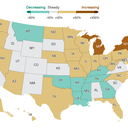The fourth COVID-19 wave is here

Coronavirus infections are on the rise yet again, all across the U.S.
The big picture: America may be at the beginning of a fourth wave in the pandemic. It will almost certainly be far less deadly than the previous three, but this persistent failure to contain the virus has real consequences, and will only make it harder to put COVID-19 behind us.
By the numbers: On average, roughly 63,000 Americans per day were diagnosed with coronavirus infections over the past week. That’s a 17% increase from the week before, and echoes the rising caseloads of the pandemic’s second wave last summer.
- Average daily caseloads increased over the past week in 25 states. The biggest spikes were in Michigan and New York.
- Even as vaccinations continue to climb, new cases only declined in five states, mainly in the Southeast.
What we’re watching: Because so many seniors have been vaccinated — 73% have gotten at least one dose — this fourth wave is likely to be a lot less deadly than the previous ones.
- Many states have also prioritized vaccinating people with underlying health conditions, which will also help constrain the increase in severe illness and death.
Yes, but: More coronavirus is always a bad outcome, and this fourth wave is a foreseeable, preventable failure that risks dragging out the pandemic and leaving more people at risk in the process.
- Millions of younger Americans with high-risk medical conditions haven’t yet been vaccinated, and therefore are still susceptible to serious illness and death as the virus spreads more aggressively.
- Hospitalizations are still rising — they’re just not likely to increase as dramatically as they have before.
- Greater spread also fosters the growth of new variants. The variants driving this outbreak are more contagious than the original strain; future variants will likely be less susceptible to our existing vaccines.
- Failing to control the virus now means it’ll be hanging around and flaring up longer into the future.
The bottom line: The vaccines work, and will spare us a lot of the death and suffering of previous surges. But four waves of infection in one year represents a clear failure to control the virus through any other means, and that will continue to hurt us.
Go deeper: Coronavirus cases are rising all over the world
Each week, Axios tracks the change in new infections in each state. We use a seven-day average to minimize the effects of day-to-day discrepancies in states’ reporting.